|
Schooners |
 |
| The schooner is a small, slender-shaped, 50 to 200-ton, two-masted, fore-and-aft rigged vessel. Schooner rigging certainly began in Holland at the end of the 15th century by perfecting the jacht, a small Dutch boat with two masts, used on inland waters. Various schooners will be used for mail and transport of goods, for fishing (Icelandic schooners), for fast connections of navies. These multiple capacities will make them choose also for other missions: the ship of Amundsen, Maud, is thus a schooner. The schooner today can also be a large school ship with several masts. But the schooner also marked the history of sailing with the first sailing boats competing in the America’s Cup. | |
 |
|
| With a small crew, sailing schooners quickly became popular for cabotage (shipping goods along the coast) | |
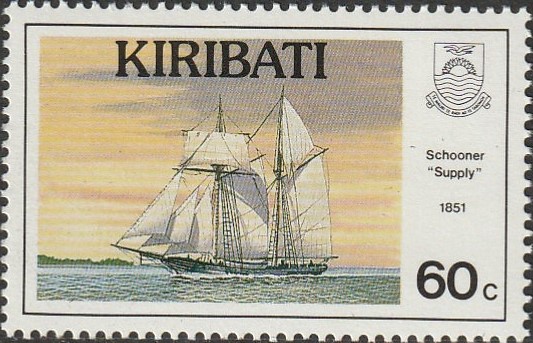 |
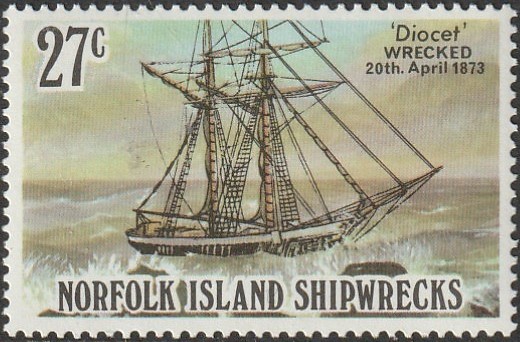 |
| SUPPLY a two-mast schooner was built in 1832 at Shoreham Sussex. The SUPPLY was used for a long time in the service between Australia and the Gilbert Islands but then she disappeared in the history. . | The name DIOCET is not the name of the ship wrecked on that date; but it was the DIAHOT at that time registered under French flag. She was used on the eastern coast of the Australian mainland where her shallow draught was a advantageous to enter river estuaries and small shallow ports, becoming a regular trader between Noumea and Norfolk Island. . |
 |
 |
| The PALARI a highly distinctive schooner-type, comes from ports of Southern Celebes and was evolved by seamen of the East Indian Archipelago. During the first 30 years after the founding of Singapore, these ships played an important part in the inter-island trade, but they declined as steamers were more and more extensively used. | Frances W Smith sailed for 12 years from Lunenburg, during the summer fishing on the Grand Banks, she was used during prohibition to carry rum. |
 |
|
| The writer Robert Louis Stevenson chartered at Hawaii in 1889 a wooden two-masted schooner for a voyage around the Pacific Islands, EQUATEUR. | |
 |
|
| A 3-masted schooner, INGRID was used to transport grain. After a few years in Gustaf Erikson’s fleet in the late 1930s, she was used for inter-island trade in the West Indies. | |
| A maritime mail service was provided on the European coasts since the 17th century, gradually extending to passenger transport. For 2 centuries, various configurations of rigging appeared, including the schooner, alongside cutters, luggers, sloops, brigs as well as feluccas, chebecs, galleys. | |
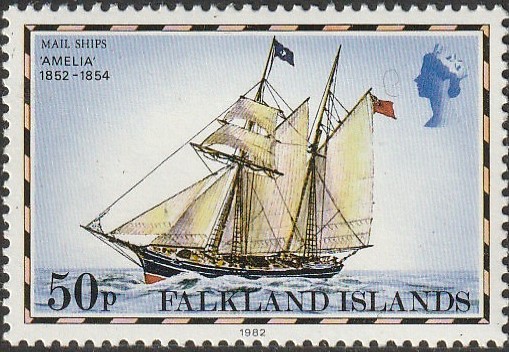 |
 |
| The Falkland Islands Company was granted a charter in January 1852 and began trading regularly between the islands, the South American coast and England. Over the next two years, the postal tariff for England went from 2/7d to 1/- per half ounce, making the mail contract a liability, so it was abandoned at the end of the two years, and AMELIA was sold. | BLACK HAWK, 110-ton schooner arrived at Port Stanley on November 20, 1872, She was the mail carrier for the colony from Jan 1873 to 1880, to and from Montevideo. |
 |
|
| FAIRY reached the Falkland Islands on 31 July 1854 after a passage of 71 days from New York, via Montevideo, after she was bought by the Falkland Island Co. . FAIRY was used for sealing and trading between the Falklands and Patagonia ; she was broken up in 1931. | |
| Schooners were widely used from the 18th century in North America in the 2-mast version for handling and speed despite adverse winds. This type of vessel was commonly used for cod fishing near Greenland, Iceland and Newfoundland. Between 1850 and 1870, each year, nearly 70 schooners leave Dunkirk for Iceland. | |
 |
 |
| The Breton and Norman ports also participated in this fishery. Unlike Newfoundland’s three-masted cod fishermen, who carried dories from which fishing took place, the crews of the Icelandic schooners, composed of twenty to twenty-four men, caught the cod in line directly from the drifting vessel. | |
 |
 |
| PINKY quickly achieved popularity because of her carrying capacity, comfort and seaworthiness. The craft was particularly adept at mackerel fishing, since it could pursue schools of these creatures as they swam windward. | Sponge Schooners were used to gather the prolific wool sponge from the beds west of the Andros Island. About 300 shooners and the same number of Sloops were working the beds. |
 |
|
| Sanne was wooden three-masted schooner Braving the prohibition to sail, in July 1942 she was attacked by a German plane and sunk north of the Faroes. The crew of 8 made it to shore in a lifeboat. | |
 |
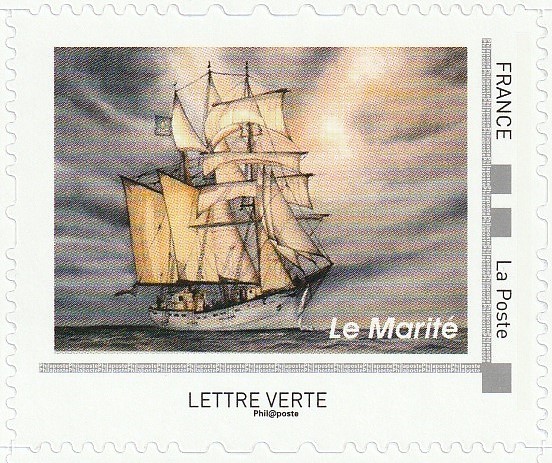 |
| With a crew of 21 on board, Marité carried out five cod fishing campaigns between 1924 and 1929. Under the Danish flag, the schooner continued fishing until 1940 and then served as a coaster. Bought by Swedes, it was sold in 2003 to a French foundation. | |
| The schooner rig, developed and optimized for maximum speed search while remaining manageable by a reduced crew for professional ships, has been adopted by the boating industry since the end of the 19th century. The American schooner built on the model of the New York pilot schooners came in 1851 to snatch from the English the cup since then called the America’s Cup. Schooners generally have two masts (but can carry up to seven). The misaine mast (forward) is shorter or the same size as the large mast. All masts are fitted with fore-and-aft or triangular sails. | |
 |
 |
| Westward was launched on March 31, 1910 at the Herreshoff Manufacturing Co. in Bristol, Rhode Island, She was designed by Nathanael Greene Herreshoff, the ‘Wizard of Bristol’, the designer of the America’s Cup defenders which turned back all six challenges from 1893 to 1920. With Captain Charlie Barr, she sailed successfully against racing yachts like Britannia, Lulworth, Meteor II, and won numerous trophies. Then she raced very successful in the Kiel Regatta, Germany in June, where she won the Emperor's Cup in a four-race series. Westward was a familiar entry for Cowes Week during this time. . | BLUENOSE was built for the cod fishery but an off-season race made it famous in 1921: the International Fishermen’s race, race between fishermen from the Maritime Provinces and New England; the trophy was then kept by the schooner for the next 17 years. Sold in 1942, as a freight transport, Bluenose sank near Haiti on a coral reef on January 28, 1946 A replica, Bluenose II was launched in 1963. . |
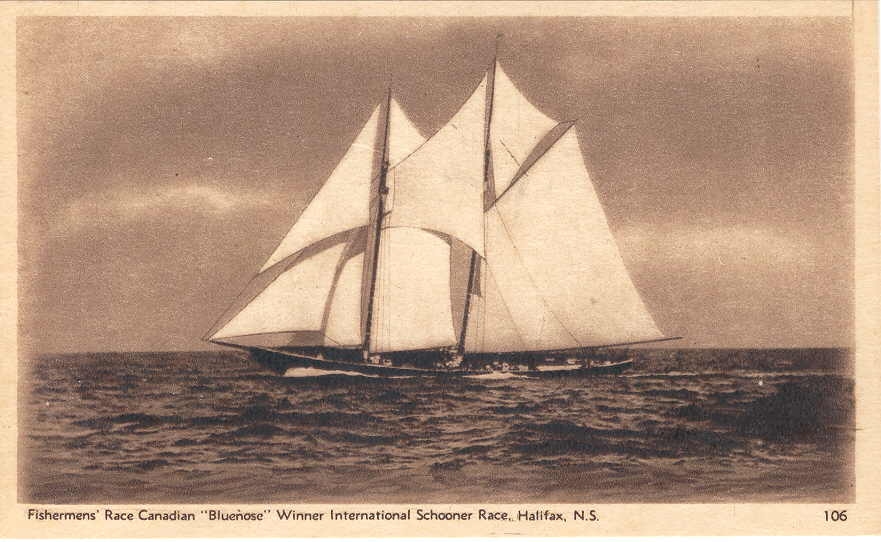 |
 |
| Albert 1er de Monaco, prince of Monaco from 1889 to 1922, nicknamed « prince navigateur », organizes numerous oceanographic and cartographic scientific expeditions in ships equipped with laboratories like the Hirondelle. | |
 |
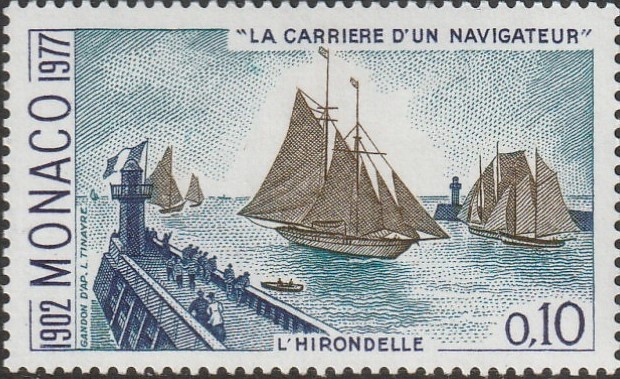 |
| Purchased in 1873, the 200-ton schooner is poetically renamed the Hirondelle (Swallow), for, he wrote, "this name should remind me of the qualities I like in the bird that wears it: adventurous resolution under an elegant, modest and thin envelope". | |
| By their speed, armed schooners were often used for connections, as avisos or for fast actions. | |
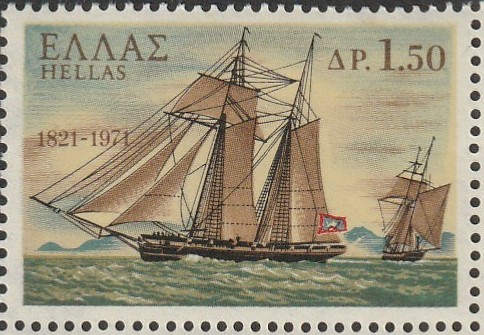 |
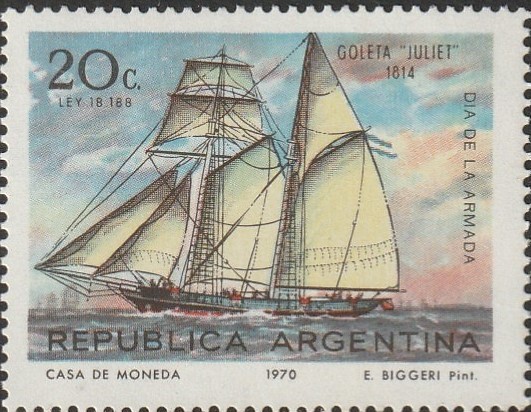 |
| Terpsichore (In Greek mythology, Terpsichore is the Muse of Dance) was built as a merchant ship but refitted in a warship during the Greek War of Independence (1821-1828) Terpsichore distinguished himself in numerous naval battles against the Ottomans, nicknamed by them as "Devilship". | In December 1811, JULIET, a topsail schooner built in the USA, was used as a transport in first squadron of the Argentina navy. Juliet was part of Admiral Brown fleet which attacked the Spanish fleet in 1814. |
 |
|
| The schooner Ancud was the ship sent by Chile in 1843 to claim sovereignty over the Strait of Magellan. The crew landed and takes possession of the place on 21 September 1843 et began to built Fort Bulnes | |
 |
 |
| On 19 September 1820, Maria Teresa, schooner of Portuguese navy, fought a very hard combat in Loango bay with a large pirate brig hosting spanish colours. | The wooden two-mast topsail schooner Papeete built in San Francisco in 1892 wa used by the French Navy in connection with its many functions stemming from the French presence in French Oceania ; then she was used by successive local ship owners for transporting goods between the islands. The ship rejoined the French Navy in 1931, but was renamed Zélée. |
 |
 |
| Built in Philadelphia in 1821, the schooner DOLPHIN cruised in the Pacific to protect American commerce and the whaling industry. She served until 2 December 1835. | The two-mast schooner Argus replaced in 1895 another Argus in Danish Custom Service She was in extremely graceful shape, very fast and able in the local waters. When the Cruising Custom Service was closed down, she was bought by the Swedish Baron Dixon and thereafter used as a yacht . |
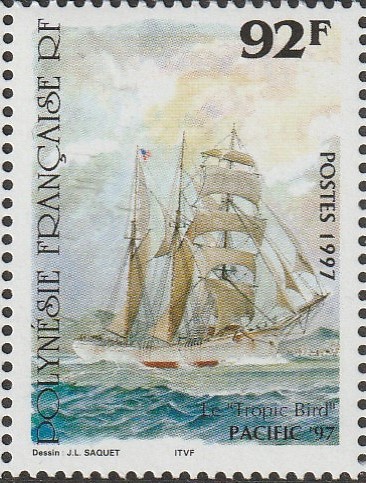 |
|
| Tropic Bird, a large three masted 368-ton trading schooner, operated a regularly service between San Francisco and Tahiti via Taiohae in the Marquesas Islands dating back to 1893. The voyage lasted 28-34 days and involved a 10-day stopover at each port of call. | |
| The development of complex rigs led to the creation of large multi-masted ships, used for trade yesterday and today as training ships, which served as models for modern tall ships. | |
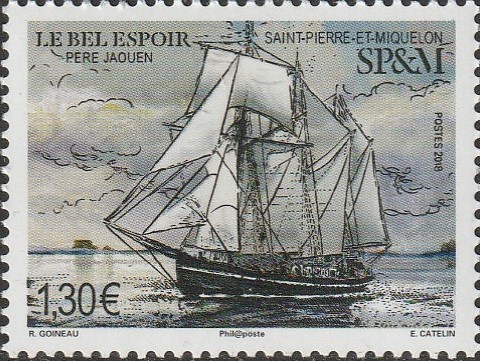 |
 |
| Le Bel Espoir II is a 29-metre three-masted schooner with a draft of 2.80m. It was built in 1944 in Denmark for the transport of livestock between Copenhagen and Hamburg. She was purchased in 1968 by the Association of Father Jaouen for educational, training, reintegration and leisure activities. Her details are now: 37.20 x 7.10 x 2.60m. (draught), length of deck 29.30m. Sail area 545 m². | Sir Winston Churchill, three-mast top-sail schooner built in 1966 took part in many Tall Ship races and reviews. The ship was sold to Greek interests and after a refit in service as a luxury charter yacht. |
 |
|
| Purchased in the Netherlands in 2006, the Lithuanian yacht Brabander belongs to the University of Klapeida and has participated to several tall ships races. | |
| In 1818 the London Missionary Society was founded, sending missionaries to Tahiti, Tonga, the Cook Islands and other South Pacific islands. In exchanges still largely governed by barter, the missionaries make themselves apostles of what we would call today a “fair trade”. And the schooners of the missionaries will largely serve for these exchanges between the islands. | |
 |
|
| Messenger of Peace was built in 1827 by Rev. John Williams. She was used to visit several islands during her 6 years of service. | |
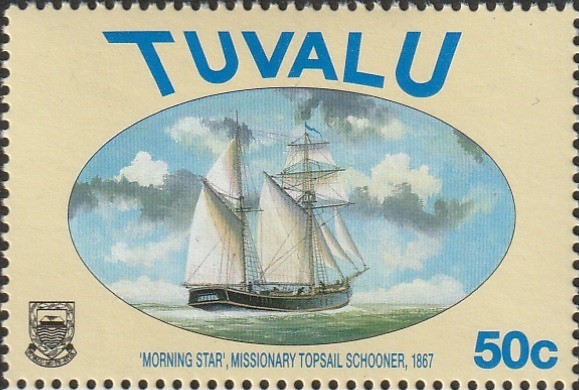 |
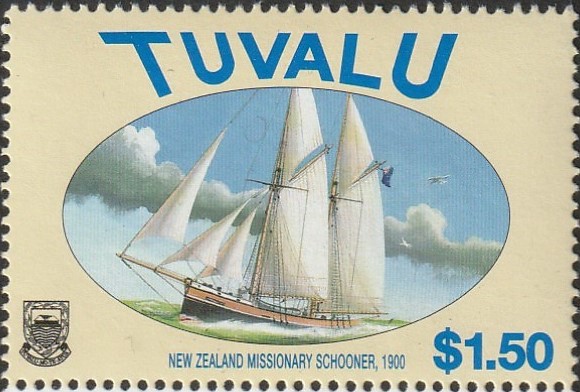 |
| Launched in 1866 in Boston, MORNING STAR (II) reached Honolulu then Gilbert Islands before sailing several years off Micronesia. | |
 |
 |
| On August 10, 1912, missionary abbot Emmanuel Rougier, heir of a New Caledonian convict, buys Christmas, an atoll from the South Pacific Ocean, belonging today to the Republic of Kiribati. On September 17, 1913 on behalf of his company, the Pacific Cocoanut Plantation Ltd. he obtains from the British government an operating authorisation valid until 2001. He founded a coconut grove employing many Tahitians, bought a superb schooner, the Ysabel Mary, and issued his own postage stamps. | Norfolk Islanders in 1925 used local pine for the keel, pine for the planks and island-grown ironwood and olive for the frames to built Resolution, named Resolution, after Cook's famous ship. .She was employed in local trading, based successively in Tonga, Fiji and Vila, New Hebrides, today Vanuatu. |
 |
 |
| Belle Poule is, with l’Étoile, a topsail schooner, built in 1932 in Fécamp, Normandy. She is a replica of the schooners of Paimpol who fished cod off the coast of Iceland, hence also the name of "Icelandic schooner". Both ÉTOILE and BELLE POULE served the Free French Forces during the Second World War, | |
|
|
Click below for the pages list |
|
|
Page on line on:
|